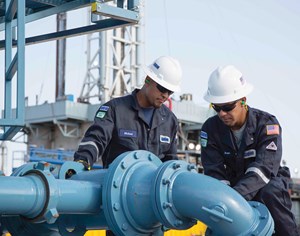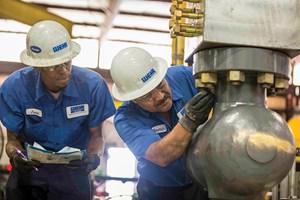An ounce of prevention: Proper training to stack pumps reduces costs
The current climate of the oil and gas market is leading operators to rethink—and potentially reconfigure—their sites and operations. To meet existing market needs, operators are choosing to pull some of their pumps out of the field to navigate current industry challenges. For operators who are considering this move as a way to reduce costs, it’s important to ensure the process for parking pumps for an extended amount of time is done properly to avoid damaging equipment and inadvertently increasing costs.
PLANNING
After pushing U.S. oil and natural gas production to record levels, operators are now looking to pump less, due to a multitude of factors. Oil and gas investment dollars are more difficult to obtain now, especially for pumping companies, which is forcing operators to rely on their own cash reserves for their operations. This creates greater financial pressure on operators, as their bottom lines may be currently squeezed. Low oil and gas prices are another factor constraining operators, as well as current gas supply outstripping demand. All of these aspects, taken together, are causing operators to carefully examine their capital expenditures and maintenance expenses to help strengthen their financial positions.
With a surplus of approximately 20 million pumping horsepower in North America, some operators may consider taking pumps offline to improve their margins by reducing labor, maintenance and consumables costs. As the market changes, operators will need the flexibility of putting idled pumps back into production, to enhance their profits while minimizing expenses, Fig. 1.

To have the flexibility to put pumps back into the field in the most cost-effective way requires pumps to be properly stored to avoid significant damage. This damage could result in tens of thousands of dollars in unforeseen costs or even render the pump unusable, requiring cannibalization from another unit or the expense of replacement. Preserving pumps ensures that they are ready when they’re needed and will ultimately save time, effort and, most importantly, money. The key to success is ensuring that the maintenance team has been trained properly on pump preservation.
Training your teams on pump preservation is an important cost-saving measure when parking pumps. Because of the potential loss of pumping time and repair costs from improper storage, we recommend that operators seek assistance to develop a comprehensive stacking/unstacking plan for their equipment. Without one, costs can quickly get out of control.
STACKING
Armed with a plan, the stacking process can begin. For example, Weir Edge Technical Services’ guidelines instruct customers on how power ends and fluid ends are to be properly protected. Power end covers are removed and visually inspected to determine if any issues like rust are present. If rust is found, it’s cleaned away, and those areas are protected from further oxidation and any other issues are corrected. The internals of the power end are then fogged with an appropriate amount of a vapor corrosion inhibitor (VCI), ensuring all internal parts receive an ample coating. All covers are replaced, and all fasteners are returned to proper torque values. Breathers are removed, and plugs are installed in their place to prevent moisture from entering the power end. The breathers are bagged and preserved for reinstallation when the pump returns to service. The pump is then labeled, noting the preservation materials used and the date that service was completed.
We also ensure that fluid ends are opened, and any standing fluids are removed. As with the power ends, any rust is cleaned, and all internal areas of the fluid end are fogged with VCI product. Once all components are reinstalled, open connections are sealed with the proper plugs, caps, covers or seals. If the fluid end is removed from the power end, any exposed pony rods and stay rods receive a protective coating to protect from corrosion and the elements. Additionally, all exposed machined surfaces receive a protective coating, and the fluid end is labeled with the preservation materials used and the service date of completion. This service paperwork is also saved for future reference.
Engineering expertise is crucial when removing pumps from service to ensure that they will perform when brought back online. The most common oversight that field personnel make when storing pumps is not protecting the equipment from moisture, especially the power end. It’s critical to remove the breather to prevent moisture from entering the pump. Once moisture is inside the pump, it can cause contamination in the lubrication system and bearings to rust. This damage would lead to a catastrophic failure, requiring the pump to be rebuilt.
Improper fluid end storage also can result in damaged fluid ends, which could require replacement rather than repair. Corrosion and moisture are the main concerns with fluid ends, but packing and seals also can suffer from compression set when stored too long. If brought back online with damaged seals or packing, the pump could leak, and the truck would not be able to pump. This would not only create unplanned downtime but also cost tens of thousands of dollars to replace the fluid end, if damaged. As operators often have 18 pumps or more in the field, having just six pumps go down would force operators to scrap a job, resulting in a detrimental loss of revenue.
Training field personnel in the proper procedures for preserving pumps is a smart investment of time that pays dividends. Weir Edge® Technical Services conducts training, free of charge, to equip pump maintenance personnel with the knowledge to maximize and preserve an operator’s capital investment, Fig. 2.

Field teams often lack the guidelines to perform the essential steps for taking a pump out of the field in a way that enables that pump or its parts to be used again. The average workforce tenure can be less than one year for some operators, and as these workers transition out of their roles, they train their replacements—yet they often haven’t been trained themselves.
This valuable, expert-led training results in field teams being able to not only perform maintenance and preservation techniques properly, but it also enables them to perform these activities faster. As operators contemplate temporarily pulling a portion of their pumps out of service, voluntarily or by requirement, to boost their margins, a long-range view should be taken to ensure those pumps are able to be returned to service or components used on active pumps without incurring unexpected costs. A comprehensive stacking/unstacking plan and proper training are key to enabling idle assets to return to service. This preserves operators’ investments and creates flexibility to easily and swiftly respond to changing conditions.
- Shale technology: Bayesian variable pressure decline-curve analysis for shale gas wells (March 2024)
- What's new in production (February 2024)
- U.S. operators reduce activity as crude prices plunge (February 2024)
- U.S. producing gas wells increase despite low prices (February 2024)
- U.S. oil and natural gas production hits record highs (February 2024)
- Dallas Fed: E&P activity essentially unchanged; optimism wanes as uncertainty jumps (January 2024)


